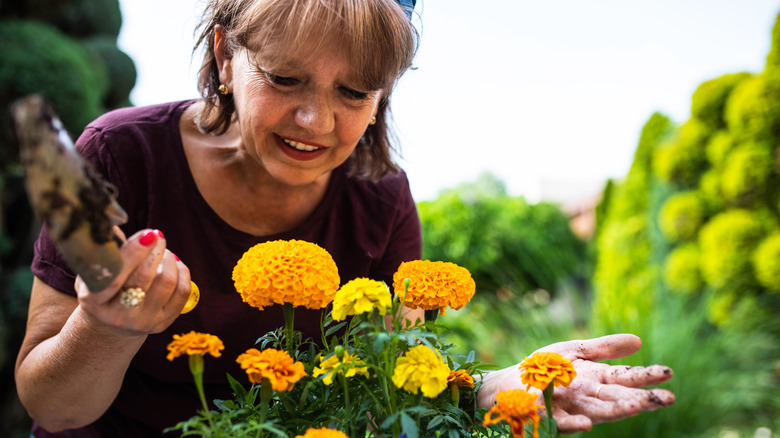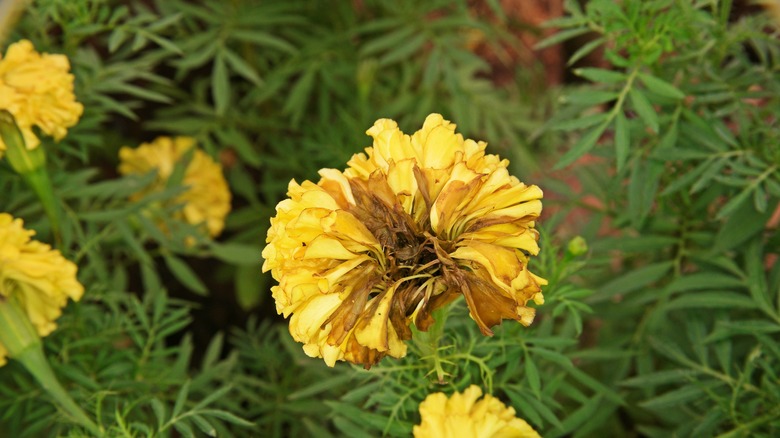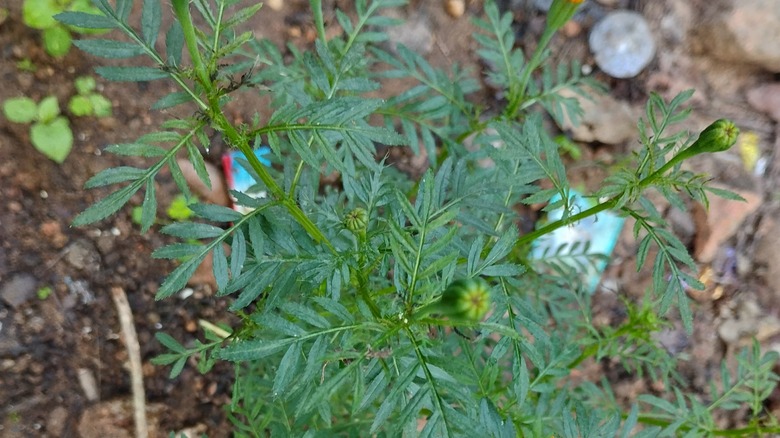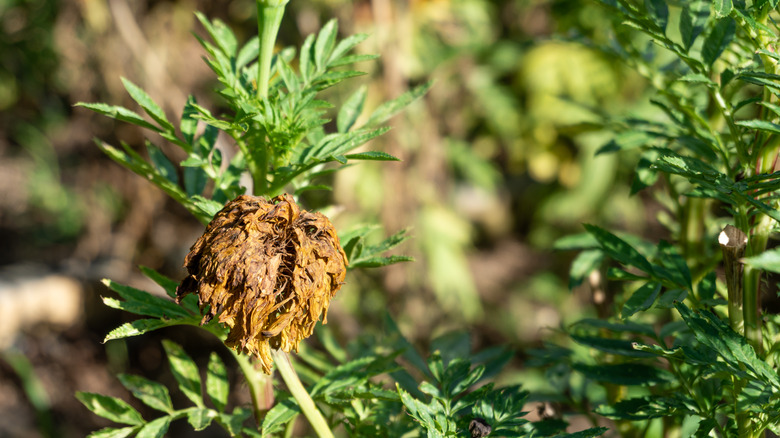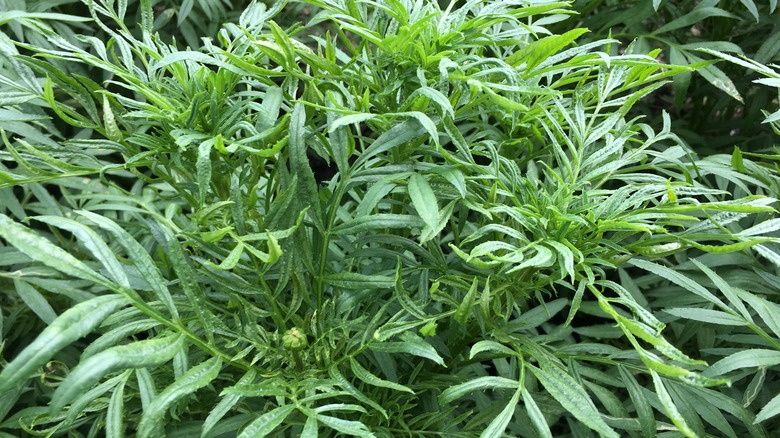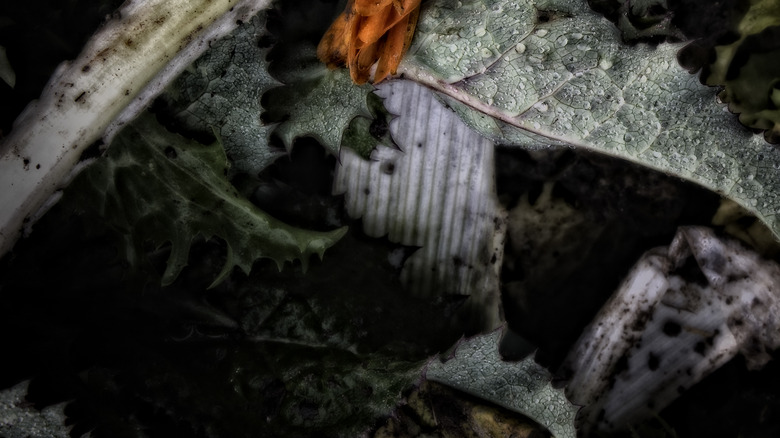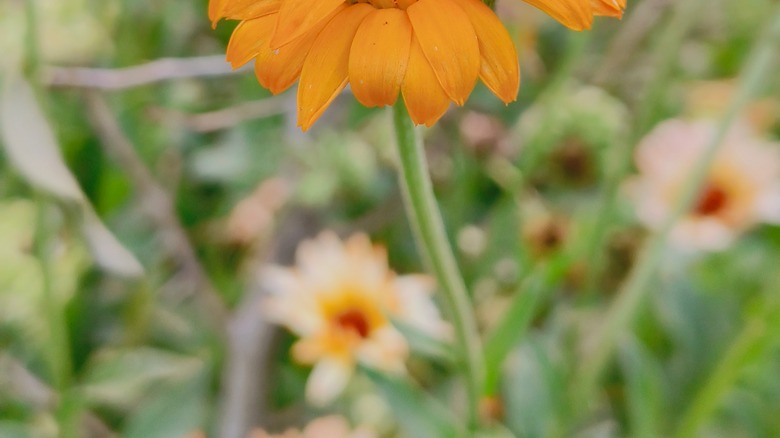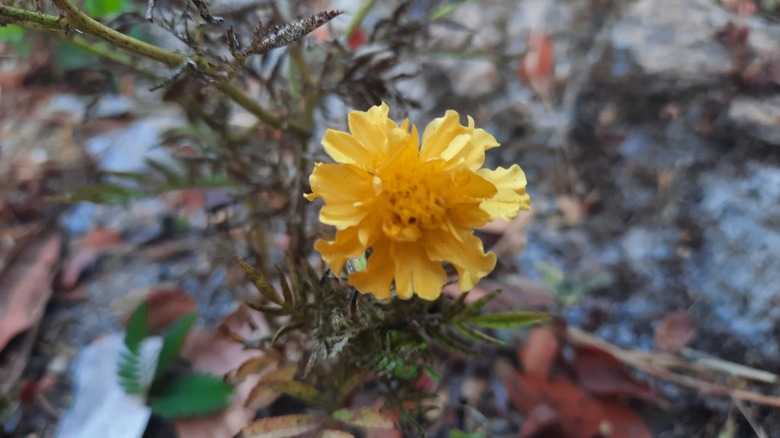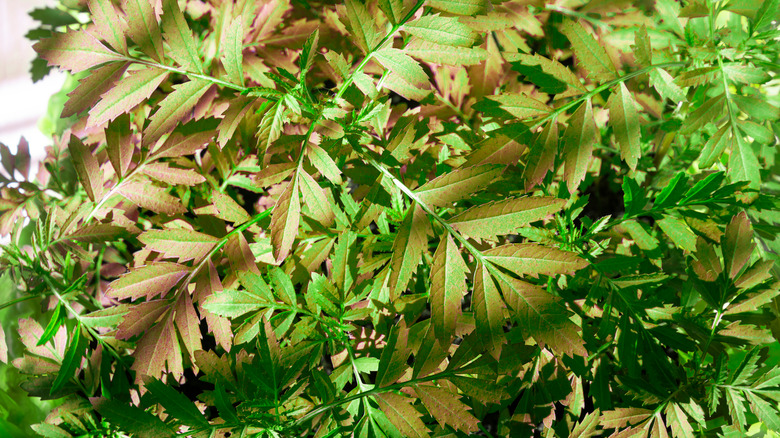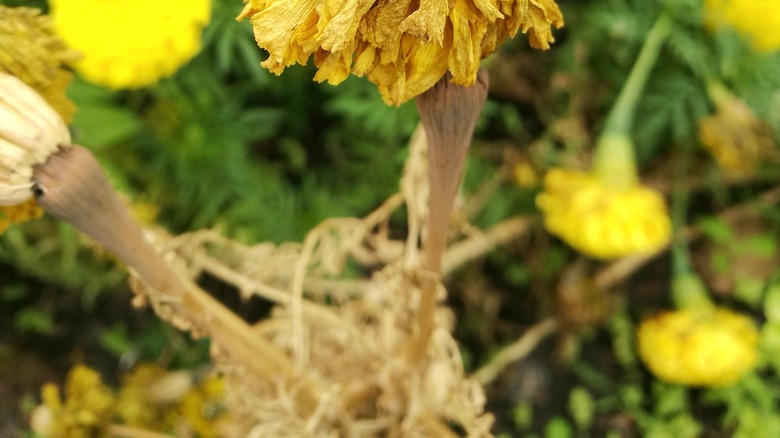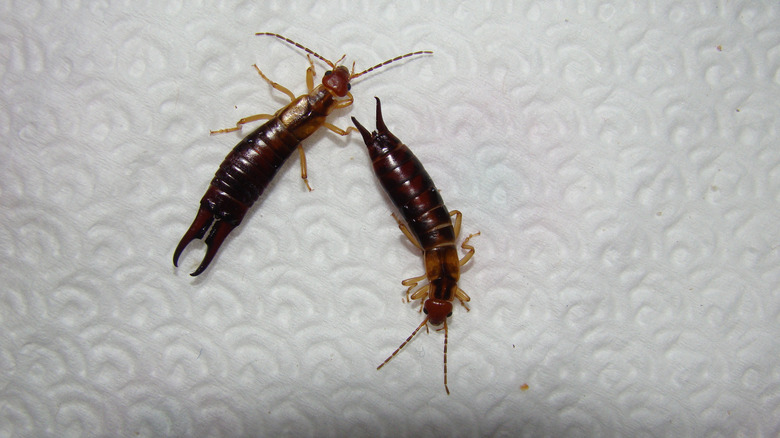11 Common Issues To Know About Before Growing Marigolds
Out of the 50 species known to science, African, French, and Signet are the all-time favorite marigolds in many gardens. These delightful annuals are easy to grow and bloom in different colors, including gold, orange, mahogany, red, and yellow. Native to Central America, they need full sun, and their blooms last all summer. Marigolds, or tagetes, are more than just eye candy, though. Their odors are known to repel wildlife such as deer and rabbits. The chemicals in the plants are also quite lethal to root-knot nematodes in the soil.
The best time of year to plant marigolds is from spring to mid-summer. Although they require little maintenance, these annuals are not without their issues. Like many other ornamentals, pests and diseases make up the bulk of the problems you have to deal with. Most of these issues leave a mark on the leaves and carnations of the plant. This makes it easier for you to notice and address the problem in time. So it pays to check on the ornamentals regularly and keep an eye on any irregularities in their appearance. If you're planning on growing marigolds in your garden, the following 11 issues are quite common among the different species of this cheerful ornamental.
White mold
White mold is a fungal disease caused by Sclerotinia sclerotiorum. It affects the stem, leaves, and flowers of the marigolds and might spread underground. The first sign of an infection is a dark green lesion on the leaf or flower that looks oily or full of water. The spores of the fungus form on the top of the lesions, taking the shape of white foam. As they mature, they turn dark and expand to cover larger areas of the stem. This causes wilting and rot of the stem and, unable to support the weight of the flower head, the marigold eventually collapses. White mold flourishes in warm and humid conditions, especially after rainfall. It can spread quickly and infect the whole flower bed.
Unfortunately, once the marigold is infected with white mold, there's no cure for it. Pull out the infected plant and burn it quickly before it spreads the disease to the rest of the flowers. The fungus can stay dormant in infected soil and plant debris for years. So avoid planting marigolds in areas where plants have been infected with the fungus within the past three years. Make sure the soil is well-draining and the plants are spaced properly to improve ventilation. Weeds act as hosts to the fungus, so removing them and keeping the soil debris-free will minimize the risk of infection.
No flowering
As an ornamental, a marigold that doesn't flower serves no conceivable purpose. It's frustrating when you grow and care for the dainty plant only to find no flower buds forming on the stems. The reasons for this mishap vary, but they mostly have to do with either the timing or the growing conditions around the plant. There might be a simple explanation for the lack of flowering. It may not be blooming season yet, as many marigolds only start flowering in early summer. But if it's not the timing factor, then it could be stress from lack of light, inadequate watering, or over-fertilizing.
For an annual, you need to act quickly and fix the problem to enjoy some marigold blooms before the season is over. If it's still early in the spring, give the marigold a few weeks and see if flower buds emerge. Make sure that it's growing in a sunny spot and getting at least six hours of full sun every day. Once established, water the plant with one inch of water once a week. Fertilize the plants only once when planting them with a balanced fertilizer.
Gray mold
Also known as botrytis blight, gray mold is another fungal infection that can devastate an entire flower bed of marigolds. Caused by Botrytis cinerea, gray mold mainly affects the flower buds or blooms but can also infect the leaves and stems. It first appears in the spring as brown spots that turn gray when the spores mature and are ready to spread. Botrytis blight causes the petals to wither and the flowers to wilt and rot. It needs humid and cool conditions to infect the plants. Temperatures under 60 degrees Fahrenheit are ideal for the fungus to become active.
When it comes to gray mold, preventing the disease is more effective than treating it. Since wet conditions often trigger the fungal infection, avoid overhead watering of the marigolds or letting moisture condense on the carnations or leaves. Any flowers with brown spots should be culled and burned before spores develop on them. Don't compost infected plants since the fungus can survive the composting process and infect new plants. Marigolds are drought tolerant, so allow the soil to dry out between irrigations to minimize moisture on the plants. Finally, you can spray the flower bed with fungicides containing fludioxonil or iprodione. They are quite effective at stopping the growth and spread of the disease.
Curly or distorted leaves
Marigold leaves are normally flat, with toothy edges, and a deep vein in the middle. All the leaves follow this shape and pattern, so any anomaly would suggest that the plant is stressed. Curly, distorted, or crinkled marigold leaves could be a sign of a virus infection or herbicide damage. If the leaf curl is accompanied by stunted growth, then the plant is infected with the ageratum enation virus (AEV). However, if the leaves are cupped, leathery, thicker than normal, and twisted, then exposure to herbicides is the reason for the deformity.
Viral infections in marigolds are serious and often untreatable. If a virus is causing the distorted leaf symptoms, then the best course of action is to get rid of the infected plants. Whiteflies transmit AEV, so controlling their population would protect the ornamentals from the disease. You can set traps for whiteflies, or invite predators like ladybugs and lacewings to the garden to manage the pests. As for damage from herbicide, as long as the exposure wasn't severe, marigolds will often recover from it and replace the affected leaves with healthy ones. Avoid spraying herbicides on windy days or when air temperatures are above 85 degrees Fahrenheit to minimize the risk of damage to the plants.
Cold damage
In their natural habitat in Central America, marigolds bask in a flood of sunlight and warm weather. Since they favor temperatures between 65 and 75 degrees Fahrenheit, a sudden drop in temperature could cause serious injury to the plants. The symptoms of the damage vary depending on the severity and length of the cold spell. However, marigolds struggle once the temperature goes under 50 degrees Fahrenheit. The leaves of the ornamental are quick to show signs of damage becoming soft and soggy, and their lush green color turns dark. Cold injury can happen either because of unpredictable weather or if the seedlings haven't been adequately hardened before they're moved outdoors.
If the cold stint is short and the weather warms up quickly, the ornamentals will recover without affecting their growth and flowering. However, severe cold conditions and early frost could kill them. Before transplanting the seedlings to the garden bed, you need to harden them. Place the potted seedlings in a sheltered place and keep the soil moist. If the night temperatures drop below 65 degrees Fahrenheit, take them back inside in the evenings. After a week, the hardened seedlings are ready to transplant without suffering cold damage.
Leggy marigolds
Marigolds vary in height depending on the species. French marigolds can be as short as 6 inches high, while African marigolds can grow to 36 inches tall. Under normal conditions, the ornamental will adhere to this maximum height. But sometimes the stems get too long and bare with the leaves growing near the tips. The resulting look is an unflattering, spindly appearance. This often happens when the marigold is growing in a poorly lit setting so it stretches its stems toward the light source. Besides the unpleasant leggy shape, not enough light also leads to smaller and fewer flowers.
One way to prevent marigolds from getting leggy is to ensure that they get plenty of light every day. Avoid growing tall plants or placing barriers next to the flower bed that would cast shade on the ornamentals. If the marigolds are growing in a planter, make sure to move the container around so that all the plants get enough sunlight during the day. As for the plants that are already leggy, you'll need to trim them back into shape. Simply pinch off the tip of the tall stems to promote lateral growth and denser foliage.
Leaf spots
Leaf spot or marigold black spot is a fungal disease that affects both African and French marigolds more than other varieties. The fungus behind the disease is Alternaria tagetica, and it affects the lower leaves of the plant first. From there, it progresses to the stems and finally appears on the flowers. The spots can be round, oblong, oval, or have irregular shapes. They also vary in color between tan and brown and sometimes have purple edges. But they usually have a black dot in the center. The pathogen thrives in cool and wet conditions. Leaf spot is more than an unsightly blemish on the ornamental, as infected marigolds often wilt and die at a quick pace.
Alternaria tagetica is an opportunistic fungus that hides on plant debris and weeds. Proper maintenance and weeding of the flower bed and burning infected plants should limit the spread of the disease. The best method for watering marigolds is watering at the roots. Early morning irrigation is recommended to allow the plants to dry before the temperatures drop in the evenings. To help the plant fight off the disease, water it regularly and apply balanced fertilizers. Fungicides containing chlorothalonil, mancozeb, copper, and thiophanate methyl are effective against marigold black spot. Spray the plants in the early spring to reduce infections.
Leaves are reddish purple
The leaves of marigolds are either lush green or dark green. Since they're the first to display symptoms of stress or ill health in the plant, purple shades on the marigold leaves are usually cause for concern. Sometimes the leaf discoloration covers large parts of the surface with reddish-purple colors and other times it appears as purple spots. The most likely causes for these unhealthy signs are nutrient deficiency, overwatering, over-fertilizing, cold temperatures, or too much sunlight. Color blemishes on the leaves usually have little effect on the plant's growth. However, underlying causes such as poor soil could lead to fewer blooms, and overwatering would make the plant susceptible to diseases such as root rot.
A thorough soil test should be the first course of action. Based on the results of the test, you can feed the marigolds with phosphorus or magnesium supplements as needed. But if the soil is fertile, then cold temperatures might be preventing the roots from processing the nutrients. Move the marigolds indoors and make sure the temperature doesn't drop below 65 degrees Fahrenheit. To check for overwatering, allow the top two inches of the soil to dry out before irrigating. Finally, protect the ornamentals from excessive exposure to sunlight during peak summer by providing shade in the afternoons.
Root and crown rot
Marigolds might experience rotting in either the root or the crown. Phytophthora, also known as water mold, is the pathogen behind this peculiar and lethal disease in the ornamentals. If you notice the mature leaves of the plant falling prematurely, stems dying, stunted growth, and wilting, your marigolds could be suffering from the disease. Unlike fungal infections, Phytophthora symptoms don't include mold growth. The pathogen lives in the soil for years and becomes active in wet conditions. Root rot is lethal if not detected and treated in time. That said, not all marigold species are prone to the disease.
To prevent root and crown rot caused by Phytophthora pathogens, make sure the soil is well-draining and avoid overwatering the plants. Getting rid of infected plants and contaminated potting soil is a surefire way to prevent future infections. However, the most effective way to avoid the damage of Phytophthora is to choose disease-resistant marigold varieties. Antigua Yellow is the least affected cultivar by the disease. Antigua Orange and Janie Deep Orange also have decent resistance to getting infected. As for Proud Yellow and Disco Mix, they're the most susceptible to root and crown rot. Avoid planting those two cultivars where the chances of infection are high.
Pests
Different pests are attracted to different parts of marigolds. But the leaves take the lion's share of pest infestations. Aphids, caterpillars of different species, whiteflies, spider mites, and leafminers favor the leaves. They feed on the sap and chlorophyll and find devious ways to hide from predators. Slugs and snails have an appetite for the young plants and devour them whole. As for earwigs and western flower thrips, they prefer the pollen and petals of the marigold flower heads. The symptoms vary depending on the offending pest and the target of infestation. Sap-sucking bugs will make holes or leave trails on the surface and might cause deformities in the leaves. Affected blooms will have necrotic spots and wither prematurely.
To control pests on marigolds, remove weeds and debris that provide hiding and nesting places for many insects. Coffee grounds and beer traps are good solutions for keeping snails and slugs out of your garden. Also, many natural predators, including predatory mites, parasite wasps, praying mantis, and beetles, feed on larvae and adult pests. Allowing them into the garden helps manage marigold pests. In the case of heavy infestations, spray the pests with a suitable insecticide. Always buy a pesticide that's specific to the bug on the marigold and read the instructions before applying the chemical.
Aster yellows
Aster yellows is a viral disease caused by phytoplasma pathogens and transmitted to marigolds by leafhoppers. When the bugs feed on the leaves of an infected plant, they become lifetime carriers of the disease. This is why if there's an infection of aster yellows in your area, you need to take precautions to protect your ornamentals. Infected marigolds have yellowing leaves with new leaves being considerably smaller than average. The growth of the plant becomes stunted both on the crown and root levels. Marigold flowers might be affected as well. The pathogen thrives in cool and wet conditions.
There's no cure for aster yellows, so prevention and management are your best line of defense. The disease infects a wide variety of plants, including ornamentals, edibles, and grasses. Once you detect an infection, remove the plant and dispose of it. Another vital strategy in keeping marigolds safe from the disease is to control leafhopper infestations. Removing weeds deprives the insects of an important food source. You can also spray the bugs with insecticidal soap, neem oil, or horticultural oil to manage their presence in the garden.
